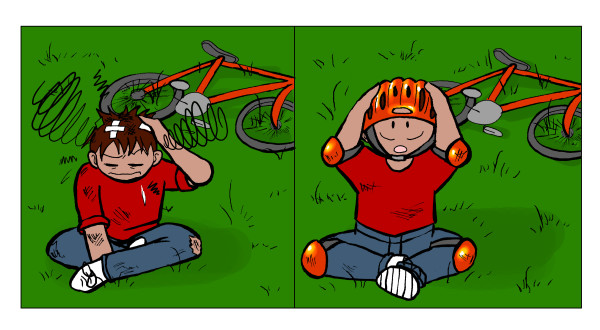By M. M. DONALDSON
Summertime isn’t summer if there aren’t a few bike rides, time hanging out at the skate park or the threat of brain injury. The enjoyment of warm weather sporting activities should also include decreasing possible life-changing injuries.
“It’s too hot,” is a poor excuse for the helmetless during the muggy days that creep into sultry nights.
“Helmet companies have done a good job with making them cool so kids wear them,” Quality Services Manager Dan Bogosian at Eisenhower Center in Ann Arbor said. While his responsibilities range from trouble-shooting transportation issues to working in the hoop house with clients who suffer from a brain injury, he is a proponent of wearing helmets. The severity of a head injury can range from concussions, which should still be taken seriously, to the next level considered traumatic brain injuries (TBIs). To minimize concussions he said “wearing helmets would be fantastic.”
Football has gained a lot of attention with brain injuries in the past few years. Litigation between professional football players and the NFL has spurred development of safer helmets, medical protocol for concussions and awareness to the long term effects of brain injuries.
Surprisingly, football ranks lower than bicycling for the number of TBIs according to the U.S. Product and Safety Commission.
Only 50 percent of bike riders regularly wear a helmet, according to a 1991 survey done by the McDonald’s Corporation and the U.S. CPSC.
Continuing the spin of helmet use and accident statistics, the most common reason for fatal biking accidents is due to head injuries.
Nearly 88 percent of serious brain injuries could be prevented if helmets were worn during bike riding, according to the American Academy of Pediatrics.
Unlike a broken arm that is a visible wound, brain injuries are non-visible. Bogosian said people do treat those who suffer from brain injuries differently. He used the example of an employer becoming frustrated with an employee who has sustained trauma to the head, but who is not visibly hurt. Especially so when issues related to the brain injury do not show up until weeks or months later.
Wearing a helmet while participating in a variety of other high velocity sports, including in-line skating and skateboarding, can reduce the risk of TBIs. Researchers Dixon and Gittelman concluded this through analysis of several studies for their paper “Pediatric helmet use: teaching patients to use their heads.”
Earlier this summer at the Ann Arbor Skatepark, Washtenaw Community College graphic design student Damien Lamberti, 41, helped organize the annual Dave Tuck Memorial Backyard Pool Jam. The event is a fundraiser for skateboarders who have cancer.
As far as helmets go, the college party promoter and Ann Arbor resident Lamberti said all the pro skaters push wearing helmets. The promoters and professionals at this event make a point of encouraging the use of helmets.
“Nothing cool about cracking your head open,” Lamberti said, remarking that no one at the event promotes being reckless.
“Michigan is the best in taking care of brain injuries,” Bogosian said for those who do suffer a brain injury. He said there are more doctors and TBI facilities in the state. He estimates that there are 30 centers in Michigan, compared to the lone center in Denver that people from five surrounding states depend on for services. Those without access to TBI services, he has witnessed, can easily end up in nursing homes.
Having the wind blowing through your hair is a great feeling, but having helmet hair is something worth suffering through.
M. M. Donaldson is a staff writer with The Voice and a journalism student at WCC. She has a bachelor of science in family and community services from Michigan State University, and has several years’ experience with nutrition issues affecting infants through older adults. Follow M.M. Donaldson on Facebook.



